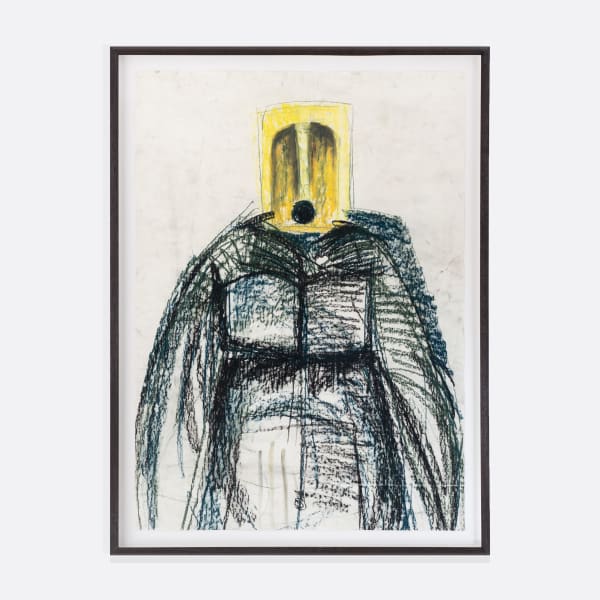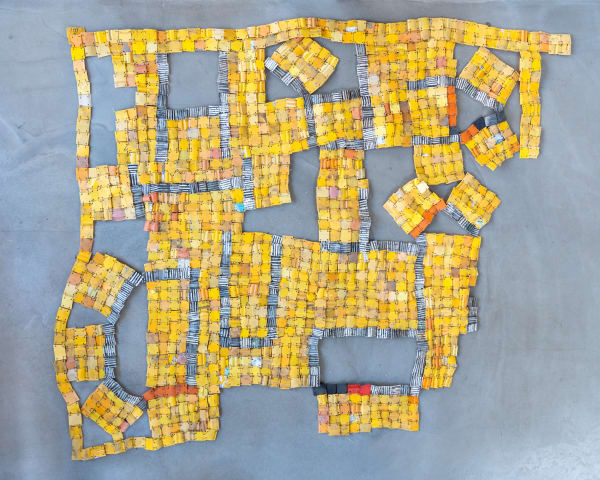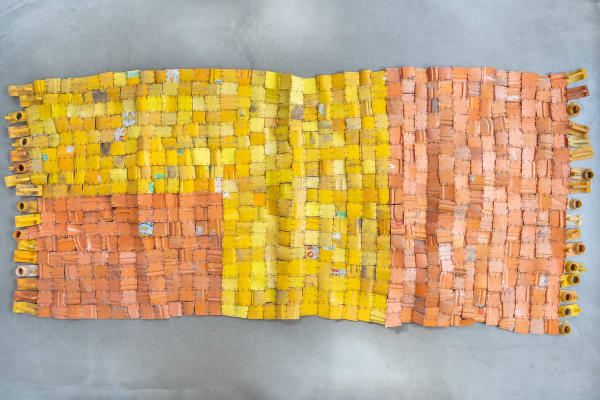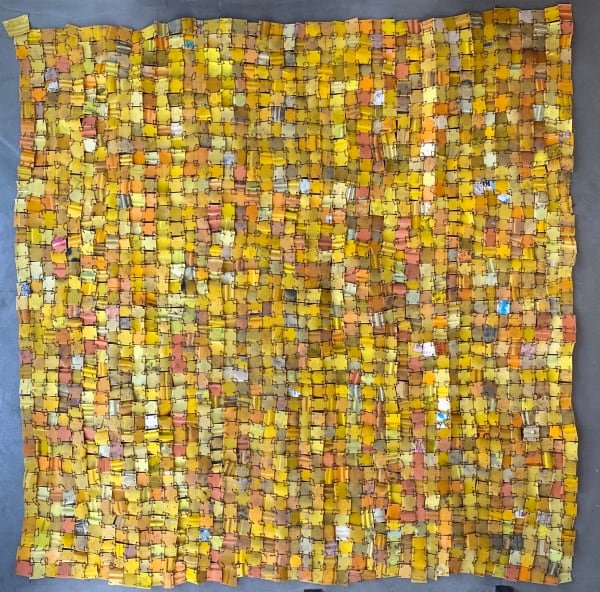Serge Attukwei Clottey I Erased Past
Serge Attukwei Clottey grew up in the traditional extended family structures of Ghana, where essentially all adults take part in the upbringing of all children within the community, and Clottey's practice is hugely influenced by the sense of comamunity this instilled in him. From the sourcing of materials to the production process, Clottey's practice is more like a communal act than an individual's work. Even the politics of trade, environment, and histories explored in the work, start with a sense of family and the community Clottey was raised in, highlighting his firm belief that in every artistic expression, the subject matter is the starting point in creating a shared understanding.
Clottey's perhaps most famous works are the yellow tapestry pieces and installations that are at the centre of his Afrogallonism project. The primary materials of these pieces are sourced from Kufuor gallons, or jerrycans, originally introduced by Europeans to Ghana to transport cooking oil, but which have been repurposed locally for a variety of uses, becoming patinated by the personal narratives of the people who have used them. Finding their next use in Clottey's hands, the yellow plastic gallons are cut into strips and interlaced with jute sacks and found objects to produce artworks which often allude to cultural references such as the Ghanaian kente motif. The gallons are both a reminder of how our pasts erratically manifest themselves, and of how the life of materials, or even of ourselves, can be extended and turned into a force for the positive, regardless of their origin or previous use. In general, the materials Clottey chooses for his works are chosen for their significance to the idea and the journey Clottey is exploring in a specific work, interlacing his own exploration with the histories of the objects. It is this process of transformation and repurposing that forms the very fabric of Clottey's art; challenging pre-set narratives, while allowing for new ideas and identities to form. This is evident not only in Clottey's tapestries, but also in the large tondo charcoal drawings, and works on linen, that reference historical African photography and western impressions of African culture. By examining personal adornments such as hairstyles, Clottey counters simplistic narratives while tracing cultural histories that exist outside of archival records. The juxtaposition of the figures' intense subjectivity and the vibrant clothing amplify that the black bodies are their own and through their assertion of independence, they push beyond antiquated notions of personhood. Working from both African traditional perspectives and his own contemporary ones, Clottey is able to describe how the African historical relationship with Europeans is interlinked through identity building, trade and materials, with a perspective that is forward looking and visionary. Reacting with art that not only calls for awareness by exposing environmental problems, but also inspires the human spirit by calling people to action, Clottey wants to help build the foundations of a re-imagined community where we conserve, recycle, and respect each other unhinged by our pasts.
Clottey studied at the Ghanatta College of Art and Design in Ghana and the Escola Guindard University of Art in Brazil. In 2019 Clottey received an Honorary Doctorate of Art from the University of Brighton. Clottey's work has been presented in solo exhibitions at The Mistake Room, Los Angeles; Ever Gold [Projects], San Francisco; Gallery 1957, Accra; Gnyp, Berlin; Lorenzelli Arte, Milan; Vestfossen Kunstlaboratorium Foundation, Oslo. His works have been included in recent group exhibitions at Desert X, Palm Desert; Christie's Beverly Hills, Los Angeles; The Moody Center, Rice University, Houston; Iziko South Africa National Gallery, Cape Town; UTA Artist Space, Los Angeles. More recently, Clottey showed his abstract and expansive sculptural installations made out of flattened, yellow Kuffuor gallon containers at Desert X AlUla (2022), Art Basel Unlimited (2023) and at the Venice Architectural Biennale (2023).
-
 Serge Attukwei ClotteyPatient Needs, 2018Plastics, wires and oil paint147 x 130 cm
Serge Attukwei ClotteyPatient Needs, 2018Plastics, wires and oil paint147 x 130 cm
57 3/4 x 51 1/4 in -
 Serge Attukwei ClotteyInteracting with Residents, 2016Plastic, wire and oil paint145 x 112 cm
Serge Attukwei ClotteyInteracting with Residents, 2016Plastic, wire and oil paint145 x 112 cm
57 x 44 in -
 Serge Attukwei ClotteyThe Watcher, 2019plastics and copper wires213 x 163 cm
Serge Attukwei ClotteyThe Watcher, 2019plastics and copper wires213 x 163 cm
83 3/4 x 64 1/4 in -
 Serge Attukwei ClotteyPrime Time III, 2016Plastics, wire, oil paint158 x 109 cm
Serge Attukwei ClotteyPrime Time III, 2016Plastics, wire, oil paint158 x 109 cm -
 Serge Attukwei ClotteyLady in Red , 2020Oil on foam core board
Serge Attukwei ClotteyLady in Red , 2020Oil on foam core board
152 x 102 cm
59 3/4 x 40 1/4 in -
 Serge Attukwei ClotteyMother and Daughter, 2017Charcoal on paper
Serge Attukwei ClotteyMother and Daughter, 2017Charcoal on paper
Natural oak frame with UV glass76 x 59 cm
30 x 23 1/4 in -
 Serge Attukwei ClotteyNo Feelings No Pain, 2017charcoal, pastel on paper122 x 107 cm
Serge Attukwei ClotteyNo Feelings No Pain, 2017charcoal, pastel on paper122 x 107 cm
48 1/8 x 42 1/8 in -
 Serge Attukwei ClotteyEndorsement , 2017charcoal on paper153 x 114 cm
Serge Attukwei ClotteyEndorsement , 2017charcoal on paper153 x 114 cm
60 1/4 x 44 7/8 in -
 Serge Attukwei ClotteyIncredible Journey , 2017charcoal on paper153 x 114 cm
Serge Attukwei ClotteyIncredible Journey , 2017charcoal on paper153 x 114 cm
60 1/4 x 44 7/8 in -
 Serge Attukwei ClotteyThe Agony, 2017charcoal on paper153 x 114 cm
Serge Attukwei ClotteyThe Agony, 2017charcoal on paper153 x 114 cm
60 1/4 x 44 7/8 in -
 Serge Attukwei ClotteyRebuild Relationships, 2018oil pastels on linen132 x 109 cm
Serge Attukwei ClotteyRebuild Relationships, 2018oil pastels on linen132 x 109 cm
52 x 42 7/8 in -
 Serge Attukwei ClotteyGesture, 2017charcoal on paper76 x 59 cm
Serge Attukwei ClotteyGesture, 2017charcoal on paper76 x 59 cm
29 7/8 x 23 1/4 in -
 Serge Attukwei ClotteyWhen Your Inner Worlds Comes in to Order, 2018oil pastel on linen132 x 109 cm
Serge Attukwei ClotteyWhen Your Inner Worlds Comes in to Order, 2018oil pastel on linen132 x 109 cm
52 x 42 7/8 in -
 Serge Attukwei ClotteyPotentials Solutions, 2018oil pastel on linen132 x 109 cm
Serge Attukwei ClotteyPotentials Solutions, 2018oil pastel on linen132 x 109 cm
52 x 42 7/8 in -
 Serge Attukwei ClotteyFriends with Benefits, 2017charcoal on paper153 x 114 cm
Serge Attukwei ClotteyFriends with Benefits, 2017charcoal on paper153 x 114 cm
60 1/4 x 44 7/8 in -
 Serge Attukwei ClotteyMother of Mary , 2018pastel and charcoal on paper102 x 66 cm
Serge Attukwei ClotteyMother of Mary , 2018pastel and charcoal on paper102 x 66 cm
40 1/8 x 26 in -
 Serge Attukwei ClotteyFront and Back , 2017charcoal on paper153 x 114 cm
Serge Attukwei ClotteyFront and Back , 2017charcoal on paper153 x 114 cm
60 1/4 x 44 7/8 in -
 Serge Attukwei ClotteyPoint the Facts, 2017charcoal, pastel on paper66 x 51 cm
Serge Attukwei ClotteyPoint the Facts, 2017charcoal, pastel on paper66 x 51 cm
26 x 20 1/8 in -
 Serge Attukwei ClotteyCrucial Ingredient , 2018plastics, wires and oil paint165 x 239 cm
Serge Attukwei ClotteyCrucial Ingredient , 2018plastics, wires and oil paint165 x 239 cm
65 x 94 1/8 in -
 Serge Attukwei ClotteyLearn to Let Go, 2019plastics and copper wires241 x 264 cm
Serge Attukwei ClotteyLearn to Let Go, 2019plastics and copper wires241 x 264 cm
94 7/8 x 104 in -
 Serge Attukwei ClotteyEnrichment Commission, 2018plastics, wires and oil paint165 x 239 cm
Serge Attukwei ClotteyEnrichment Commission, 2018plastics, wires and oil paint165 x 239 cm
65 x 94 1/8 in -
 Serge Attukwei ClotteyCreation Process, 2017plastics, aluminium plates, wires, and oil paint163 x 206 cm
Serge Attukwei ClotteyCreation Process, 2017plastics, aluminium plates, wires, and oil paint163 x 206 cm
64 1/8 x 81 1/8 in -
 Serge Attukwei ClotteyLifelong Learners, 2019Plastic and copper wires355 x 150 cm
Serge Attukwei ClotteyLifelong Learners, 2019Plastic and copper wires355 x 150 cm
139 3/4 x 59 1/8 in -
 Serge Attukwei ClotteyGrowing in Confidence , 2019plastics, wires and oil paint272 x 200 cm
Serge Attukwei ClotteyGrowing in Confidence , 2019plastics, wires and oil paint272 x 200 cm
107 1/8 x 78 3/4 in -
 Serge Attukwei ClotteyYour Voice to be the Plight, 2017Plastics, aluminium plates, wires, and oil paint153 x 206 cm
Serge Attukwei ClotteyYour Voice to be the Plight, 2017Plastics, aluminium plates, wires, and oil paint153 x 206 cm
60 1/4 x 81 1/8 in -
 Serge Attukwei ClotteyUp for Yourselves, 2017plastic, wires and oil paint211 x 178 cm
Serge Attukwei ClotteyUp for Yourselves, 2017plastic, wires and oil paint211 x 178 cm
83 1/8 x 70 1/8 in -
 Serge Attukwei ClotteyAbsorb, 2018plastics, wires and oil paint228 x 335 cm
Serge Attukwei ClotteyAbsorb, 2018plastics, wires and oil paint228 x 335 cm
89 3/4 x 131 7/8 in -
 Serge Attukwei ClotteyUntold Stories , 2017-2019plastic and steel wire355 x 132 cm
Serge Attukwei ClotteyUntold Stories , 2017-2019plastic and steel wire355 x 132 cm
59 1/8 x 20 1/2 in -
 Serge Attukwei ClotteyDifference , 2021plastics and wire213 x 221 cm
Serge Attukwei ClotteyDifference , 2021plastics and wire213 x 221 cm
83 7/8 x 87 1/8 in































